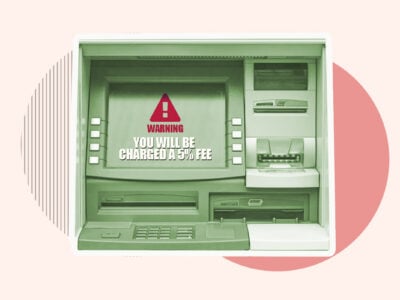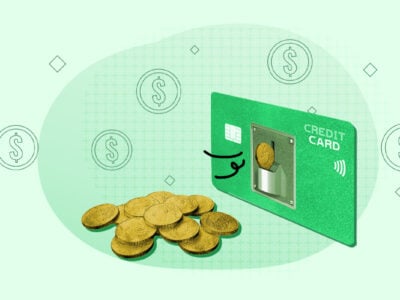If you need quick cash and your debit card doesn’t have enough funds, you may be considering taking out a cash advance on your credit card. Before you hit up the nearest ATM, learn what exactly a cash advance is, how to do one the right way, and why it may be more expensive than you think.
Table of Contents
What is a cash advance on a credit card?
A cash advance is a short-term loan that you take out with your credit card. It’s among the most common ways to get cash from a credit card. Cash advances can be performed at ATMs, banks, or online.
Although cash advances are a convenient way to get cash quickly, they come with steep fees and a higher-than-normal APR (aka credit card interest rate). These downsides mean that, although taking out a cash advance can be useful in a pinch, you shouldn’t make a habit of it.
How to do a cash advance on a credit card
Before you begin the actual cash advance process, you need to check three pieces of information on your credit card:
- Whether your card allows cash advances: Not all credit cards allow cash advances; in particular, many credit cards for bad credit and starter credit cards do not. To check whether or not your credit card has this functionality, you can check your credit card statement, log into your online credit card account and search your card’s rates and terms, or call your issuer.
- Your cash advance limit: If your card does allow cash advances, it may not allow you to take out your entire credit limit through an advance. In fact, many credit cards have a unique cash advance limit. To find this information, check your credit card statement or contact your issuer.
- Your PIN: To perform a cash advance at an ATM, you’ll need to enter your credit card’s PIN. You may have been given a PIN with your offer letter when you first received your card, or set one yourself when activating the card. If you don’t know what your PIN is, check your credit card account online or call your card issuer. Beware that your issuer may refuse to give you a PIN over the phone, opting instead to send a new PIN in the mail.
If you weren’t able to find your PIN, you’ll need to take out a cash advance by visiting a bank or transferring funds from your credit to your checking account online (this option is only available if you have a checking account with the same bank that issues your credit card).
If you have your PIN, you can go to an ATM and get a cash advance. To get a cash advance at an ATM, follow these steps:
- Go to an ATM that accepts your credit card type (e.g., Visa, Mastercard, etc.).
- Put your card into the ATM and enter your PIN.
- Select “Withdrawal” or “Cash Advance” when asked what type of transaction you want to make.
- Enter the amount of cash you’d like to withdraw.
- Accept the fees and terms and verify the transaction.
- Take your cash and take back your credit card from the ATM.
- Wait for the withdrawal to show up on your credit card statement.
- Pay off the withdrawal balance as soon as possible.
As you can see, credit card cash advances at an ATM work much the same way as debit card withdrawals. The major difference is the cost of a cash advance—which is much higher than the cost of using a debit card to take out money.
How much do cash advances cost?
The cost of a cash advance varies by credit card, cash advance method, and the amount you withdraw. However, cash advances are fairly expensive across the board because of high fees and APRs.
Here are the costs to keep in mind before committing to a cash advance:
- ATM fees: If you’re taking money out on a cash advance at an ATM, you’ll likely be charged ATM processing fees. Fees vary by ATM networks and locations. You may be able to find an ATM within your credit card’s network that waives the ATM fee, though it’s more likely you’ll pay around $3 for your ATM surcharge, according to a study by the Statista Research Department. 1
- Cash advance fee: Credit cards charge cash advance fees. What you’re charged will likely depend upon your transaction amount and will be added to your outstanding balance. Common cash advance fees are 5% of the amount you’re withdrawing (with a $5 or $10 minimum). Some cards may waive your first cash advance fee, but this isn’t very common.
- Cash advance APR: Once your cash advance balance (the amount withdrawn and the cash advance fee combined) have been added to your credit card statement, they’ll begin accumulating interest at the cash advance interest rate. Cash advance APRs tend to be higher than purchase APRs, so cash advances can accumulate interest more quickly than standard credit card purchases.
Not only do cash advances come at the above costs, but they also don’t benefit from a grace period. A grace period on a credit card is usually a 21–30 day span in which your charges won’t accrue interest. Cash advances are exempt from this period, and will be charged interest immediately.
Does a cash advance hurt your credit score?
Cash advances don’t directly hurt your credit score, but they can have an impact on it nonetheless. There are two main ways making a cash advance can hurt your credit:
- They’re hard to repay: Cash advances are usually taken out in large sums and begin accruing interest (at a high rate) immediately. This can quickly add to your credit card debt and make paying your monthly bill more difficult. As your payment history is the biggest factor in the calculation of your credit score, missed or late payments can seriously bring down your credit score.
- They raise your credit utilization rate: Your credit utilization rate is the amount of your credit you’re currently using. The more charges you put on your credit card, the higher your rate will be, which hurts your score. Having a cash advance balance on your card can easily raise your utilization rate to dangerous levels.
Essentially, cash advances are like any other charge you put on your credit card—they’re really only harmful to your credit if you’re not able to pay them off promptly.
However, because cash advances come with a higher interest rate and extra fees, they’re harder to pay off than most purchases. This makes them more dangerous to your credit score.
Alternatives to cash advances
If you’re worried about the high cost of cash advances and the potential harm to your credit score, there are other ways of getting quick funds. Try:
- A debit card: If you have money in the bank and you just need to get access to it, you can use a debit card to withdraw money from your checking account. Debit cards are meant for this purpose, in contrast to credit cards, which aren’t really meant for withdrawing cash from an ATM (which is why you’ll be charged extra fees).
- Borrowing money: On the other hand, if the problem is that you’re running low on funds, you can take out a personal loan. You’ll still have to repay whatever you borrow, but the installment loans offered by most lenders have much lower interest rates than cash advances. If your credit isn’t good enough to secure a loan, you might also be able to borrow money from a family member or friend.
- Money order or wire transfer: Besides cash advances, there are several other ways of getting cash from a credit card, including getting a money order or performing a wire transfer. However, these methods come with many of the same downsides as cash advances.
If you’re really in a bind, you can also drum up some cash by selling some of your things. You may have unwanted possessions that you’ll be able to sell on an online marketplace or by having a yard sale.
Methods that you shouldn’t consider
If none of the methods above will work for you, it’s understandable if you’re desperate for an alternative. However, don’t be tempted by the following:
- Pawn shops: It’s possible to get cash quickly by pawning valuable items (e.g., jewelry). However, this isn’t usually a good idea. Pawn shops are notorious for offering very low value for what you’re pawning, and they charge high interest rates that make it unlikely you’ll get your item back.
- Payday loans: In many states, it’s possible to take out a very short-term loan (known as a payday loan). However, as with pawn shops, most payday lenders are predatory and charge extremely high interest rates (up to 20 times higher than cash advances). This makes getting out of payday loan debt very difficult, which can trap you in an endless spiral of debt.
If you’re in enough financial trouble that you’re considering those options, your best move is probably to get help from a professional.
Look for a nonprofit credit counseling agency in your area—while some of their services cost money, many will be willing to set up an initial consultation with you for free, and they might be able to point you towards other options you haven’t considered.






